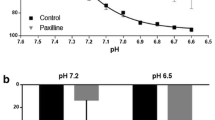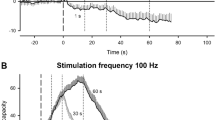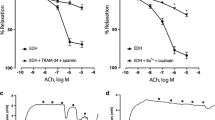Abstract
Several regulatory mechanisms have been proposed for the exercise hyperemia in skeletal muscles. Since different vasoactive factors might interact during the hyperemic response, we investigated the influence of elevated K+ concentrations on hyperosmolarity (HO)-induced vasorelaxations. Small gluteal rat arteries were isolated and mounted in an organ bath for isometric tension recording. After precontraction with norepinephrine, 20 (S20), 40 (S40) or 60 mM (S60) sucrose was added in control conditions (5 mM K+; K5) or in the presence of additional 3 (K8) or 5 mM (K10) K+. Removal of the endothelium and the addition of ouabain, Ba2+, iberiotoxin or 18-α glycyrrhetinic acid (αGA) were used to study the underlying mechanisms. Sucrose evoked significant concentration-dependent vasorelaxations (S20 15.62±1.61%; S40 26.47±1.71%; S60 43.66±2.50%), which were significantly increased on addition of 3 and 5 mM. After removal of the endothelium and in the presence of 5×10−5 M αGA, the influence of K+ was significantly blocked but not in the presence of 5×10−5 M ouabain. The KIR channel inhibitor Ba2+ and BKCa channel inhibitor iberiotoxin totally abolished the potentiating effect. We conclude that K+ significantly enhances the relaxing effect of HO in gluteal blood vessels. We hypothesize that K+ may stimulate the endothelial KIR channels which elicits the release of a mediator of the BKCa channels. This factor may be transferred through myo-endothelial gap-junctions to the smooth muscle cells where modulation of the BKCa channels sensitizes the arteries for hyperosmolarity-induced relaxations.




Similar content being viewed by others
References
Calderone V (2002) Large-conductance, Ca2+-activated K+ channels: function, pharmacology and drugs. Curr Med Chem 9:1385–1395
De Clerck I, Boussery K, Pannier JL, Van de Voorde J (2003) Potassium potently relaxes small rat skeletal muscle arteries. Med Sci Sports Exerc 35:2005–2012
De Clerck I, Boussery K, Pannier JL, Van de Voorde J (2005a) Hyperosmolarity increases K+-induced vasodilatations in rat skeletal muscle arterioles. Med Sci Sports Exerc 37:220–226
De Clerck I, Guyssens B, Pannier JL, Van de Voorde J (2005b) Hyperosmolarity causes BKCa-dependent vasodilatations in rat skeletal muscle arteries. Med Sci Sports Exerc (in press)
Doughty JM, Boyle JP, Langton PD (2001) Blockade of chloride channels reveals relaxations of rat small mesenteric arteries to raised potassium. Br J Pharmacol 132:293–301
Edwards G, Weston AH (2004) Potassium and potassium clouds in endothelium-dependent hyperpolarizations. Pharmacol Res 49:535–541
Fleming I (2004) Cytochrome P450 epoxygenases as EDHF synthase(s). Pharmacol Res 49:525–533
Juel C, Pilegaard H, Nielsen JJ, Bangsbo J (2000) Interstitial K+ in human skeletal muscle during and after dynamic graded exercise determined by microdialysis. Am J Physiol 278:R400–R406
Kjellmer I et al (1965) The potassium ion as a vasodilator during muscular exercise. Acta Physiol Scand 63:460–468
Lundvall J, Mellander S, White T (1969) Hyperosmolarity and vasodilatation in human skeletal muscle. Acta Physiol Scand 77:224–233
Massett MP, Koller A, Kaley G (2000) Hyperosmolarity dilates rat skeletal muscle arterioles: role of endothelial K-ATP channels and daily exercise. J Appl Physiol 89:2227–2234
Mellander S, Johansson B, Gray S, Jonsson O, Lundvall J (1967) The effects of hyperosmolarity on intact and isolated vascular smooth muscle: possible role in exercise hyperemia. Angiologica 4:310–322
Mulvany MJ, Warshaw DM (1979) Active tension-length curve of vascular smooth-muscle related to its cellular components. J Gen Physiol 74:85–104
Radegran G, Hellsten Y (2000) Adenosine and nitric oxide in exercise-induced human skeletal muscle vasodilatation. Acta Physiol Scand 168:575–591
Rummery NM, Hill CE (2004) Vascular gap junctions and implications for hypertension. Clin Exp Pharmacol Physiol 31:659–667
Scott JB, Radawski D (1971) Role of hyperosmolarity in the genesis of active and reactive hyperemia. Circ Res 28–29:I-26–I-32
Scott J, Frohlich E, Hardin R, Haddy F (1961) Na+, K+, Ca2+, and Mg2+ action on coronary vascular resistance in the dog heart. Am J Physiol 201:1095–1100
Shimokawa H, Matoba T (2004) Hydrogen peroxide as an endothelium-derived hyperpolarizing factor. Pharmacol Res 49:543–549
Skinner NS, Costin JC (1970) Interactions of vasoactive substances in exercise hyperemia: O2, K+ and osmolarity. Am J Physiol 219:1386–1392
Skinner NS, Costin JC (1971) Interactions between oxygen, potassium and osmolarity in regulation of skeletal muscle blood flow. Circ Res Suppl 1:73–85
Taylor HJ, Chaytor AT, Evans WH, Griffith TM (1998) Inhibition of the gap junctional component of endothelium-dependent relaxations in rabbit iliac artery by 18-alfa glycyrrhetinic acid. Br J Pharmacol 125:1–3
Triggle C, Ding H (2002) Endothelium-derived hyperpolarizing factor: is there a novel chemical mediator? Clin Exp Pharmacol Physiol 29:153–160
Weiger TM, Hermann A, Levitan IB (2002) Modulation of calcium-activated potassium channels. J Comp Physiol 188:79–87
Wilson JR, Kapoor SC, Krishna GG (1994) Contribution of potassium to exercise-induced vasodilation in humans. J Appl Physiol 77:2552–2557
Acknowledgements
This study was supported by the Fund for Scientific Research-Flanders.
Author information
Authors and Affiliations
Corresponding author
Rights and permissions
About this article
Cite this article
De Clerck, I., Pannier, JL. & Van de Voorde, J. K+ potentiates hyperosmolarity-induced vasorelaxations in rat skeletal muscle arterioles. Eur J Appl Physiol 96, 679–685 (2006). https://doi.org/10.1007/s00421-005-0128-y
Accepted:
Published:
Issue Date:
DOI: https://doi.org/10.1007/s00421-005-0128-y




